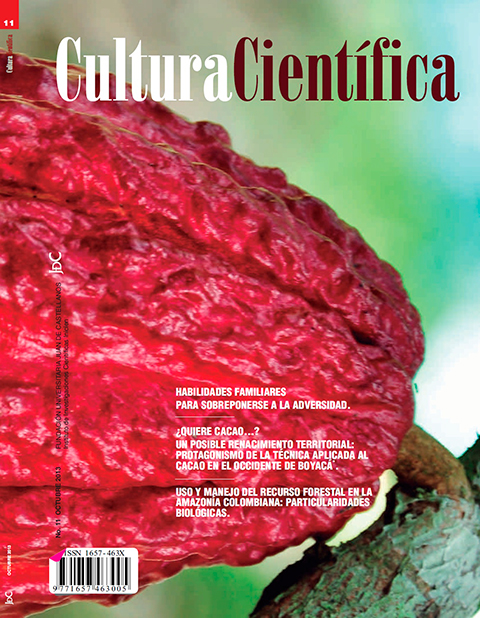Palavras-chave:
Metales pesados, Modelo cinético de Langergen, Modelo cinético de Ho, Remoción, Modelos linearizados.Resumo
La biosorción surge como una tecnología económica y favorable para el ambiente, empleada para la remoción de contaminantes como metales tóxicos pesados, gracias a algunos grupos funcionales presentes en la biomasa que le confieren la capacidad de atraparlos. El presente estudio evaluó la influencia del pH y la cinética biosorción de plomo y cobre en soluciones sintéticas con biomasa de Zantedeschia aethiopica, empleando los modelos de Langergen de primer y seudoprimer orden y el modelo de Ho de seudosegundo orden. De los valores de pH evaluados, el 3.0 fue el óptimo para la biosorción de plomo con un 98,395 % y el pH 4.0 para el cobre con un 51,85 %, para una concentración inicial de 25 mg/L de cada metal. El mecanismo fue descrito por el modelo cinético de Ho de seudosegundo orden, empleando coeficientes de correlación (Valores de R2 por encima de 0,99) y los modelos linearizados.Downloads
Referências
AKINBIYI, A. 2000. Removal of lead from aqueous solutions by adsorption using peat moss, University Of Regina.
ATSDR (Agency for Toxic Substances and Disease Registry), 2004. Toxicological profile for Cooper. Atlanta, GA: U.S. Department of Health and Human Services, Public Health Service.
ATSDR (Agency for Toxic Substances and Disease Registry), 2005. Toxicological profile for Lead. Atlanta, GA: U.S. Department of Health and Human Services, Public Health Service.
BELMONT M. & METCALFE C., 2003. Feasibility of using ornamental plants (Zantedeschia aethiopica) in subsurface flow treatment wetlands to remove nitrogen, chemical oxygen demand and nonylphenol ethoxylate surfactants—a laboratory-scale study, Ecological Engineering 21: 233 – 247.
CHEN, C. et al, 2012. Biosorption of cadmium by CO2-fixing microalga Scenedesmus obliquus CNW-N, Bioresource Technology 105: 74 – 80.
EWERS, U. & SCHLIPKÖTER, H. 1991. Lead, E. Merian (Ed.), Metals and their compounds in the environment, VCH, Weinheim (1991), pp. 971–10.
FERNÁNDEZ N. et al, 2005. Niveles de Metales Pesados en Macrófitas filtradoras en el sistema de humedales de la Universidad de Pamplona. Informe preliminar. Vicerrectoría de investigaciones. 25pp.
FERNÁNDEZ, N. 2007. Capacidad Biosorbente de Zanthedeschia aethiopica como Alternativa Biotecnológica para la Remoción de Plomo en Soluciones Acuosas, Universidad de Pamplona, Tesis.
GUPTA, S. et al. 2009. Kinetic and isotherm modeling of lead (II) sorption onto some waste plant materials. Chemical Engineering Journal 148: 226 – 233.
HAWARI, A. YMULLIGAN, C. 2006. Biosorption of lead (II), cadmium (II), copper (II) and nickel (II) by anaerobic granular biomass.Bioresour Technol 97 (4): 692-700.
HO, Y. et al. 1995.Batch nickel removal from aqueous solution by Sphagnum moss peat, Wat. Res 29 (5): 1327 – 1332.
JOHNSON, F. 1998. The genetic effects of environmental lead. Mutation Research 410:
123 – 140.
KALMYKOVA, Y. et al. 2008. Adsorption of Cd, Cu, Ni, Pb and Zn on Sphagnum peat from solutions with low metal concentrations.Journal of Hazardous Materials 410: 123 – 140.
KESKINKAN O. et al, 2003. Heavy metal adsorption characteristics of a submerged aquatic plant (Myriophyllum spicatum), Process Biochemistry, 39: 179-183.
KESKINKAN, O. et al. 2004. Heavy metal adsorption properties of a submerged aquatic plant (Ceratophyllum demersum). Bioresource Technology 92: 197 – 200.
KUMAR D. et al, 2010. Biosorption of Pb (II) from aqueous solutions using chemically modified Moringa oleifera tree leaves, Chemical Engineering Journal 162: 626 – 634.
KUMAR, Y. et al. 2006. Equilibrium and kinetic studies for the biosorption system of copper (II) ion from aqueous solution using Tectona grandis L.f. leaves powder, Journal of Hazardous Materials B137: 1211 – 1217.
KUMARI, P. et al. 2005. Arsenic removal from the aqueous system using plant biomass: a
bioremedial approach. J Ind Microbiol Biotechnol 32: 521 – 26.
LU, D. et al. 2009. Removal of Pb (II) using the modified lawny grass: Mechanism, kinetics, equilibrium and thermodynamic studies. Journal of Hazardous Materials 166: 239 – 247.
MARTINS, B. et al. 2006. Sorption and desorption of Pb2+ ions by dead Sargassum sp.
Biomass. Biochemical Engineering Journal 27: 310–314.
MIRETZKY, P. et al. 2006. Simultaneous heavy metal removal mechanism by dead macrophytes. Chemosphere 62 (2): 247–54.
NRIAGU, J. 1978. The biogeochemistry of Pb in the environment. Elsevier, Amsterdam.
PAVASANT, P. et al. 2006. Biosorption of Cu2+, Cd2+, Pb2+, and Zn2+ using dried marine green macroalga Caulerpa lentillifera.Bioresource Technology 97: 2321–2329.
SCHNEIDER, I. et al. 2001. Biosorption of metals onto plant biomass: exchange adsorption or surface precipitation?, Int. J. Miner. Process 62: 111–120.
SUBRAMANIAN, K. & CONNOR, J. 1991. Lead contamination of drinking water metals leaching from soldered pipes may pose healthhazard. J Environ Health 54:29–32.
TANG, Y. et al. 2013. Removal of lead ions from aqueous solution by the dried aquatic plant, Lemna perpusilla Torr. Journal of Hazardous Materials 244 – 245: 603 – 612.
UCUN, H. et al. 2003. Biosorption of lead (II) from aqueous solution by cone biomass of Pinus sylvestris, Desalination 154: 233 – 238.
VILAR, V. et al. 2005. Equilibrium and kinetic modelling of Pb2+ biosorption by granulated agar extraction algal waste. Process Biochemistry 40: 3276 – 3284.
VOLESKY, B. 2003. Sorption and Biosorption. (ISBN 0-9732983-0-8) BV-Sorbex, Inc. St. Lambert (Montreal), Quebec, Canada, 316 pp.
WANG, J. & CHEN C. 2006.Biosorption of heavy metals by Saccharomyces cerevisiae: A review. Biotechnology Advances 24: 427–451.
WANKASI, D. et al. 2006. Sorption kinetics of Pb2+ and Cu2+ ions from aqueous solution by Nipah palm (Nypa fruticans Wurmb) shoot biomass. Electronic Journal of Biotechnology 9 (5): 587-592.
WATANABE, M. 1997. Phytoremediation on the brink of commercialization. Environ Sci Technol 31: 182– 186.
YANG, G. & LIN, S. 1998.Removal of Lead from a Silt Loam Soil by Electrokinetic Remediation. Journal of Hazardous Materials 58: 285 – 299.
YAN, R. et al. 2011. Cadmium and mercury removal from non-point source wastewater by a hybrid bioreactor, Bioresource Technology 102: 9927 – 9932.
YUVARAJA, G. 2013. Biosorption of Pb(II) from Aqueous Solution by Solanum melongena Leaf Powder as a Low-Cost Biosorbent Prepared from Agricultural Waste, Colloids and Surfaces B: Biointerfaces (2013), http://dx.doi.org/10.1016/j.colsurfb.2013.09.039
ATSDR (Agency for Toxic Substances and Disease Registry), 2004. Toxicological profile for Cooper. Atlanta, GA: U.S. Department of Health and Human Services, Public Health Service.
ATSDR (Agency for Toxic Substances and Disease Registry), 2005. Toxicological profile for Lead. Atlanta, GA: U.S. Department of Health and Human Services, Public Health Service.
BELMONT M. & METCALFE C., 2003. Feasibility of using ornamental plants (Zantedeschia aethiopica) in subsurface flow treatment wetlands to remove nitrogen, chemical oxygen demand and nonylphenol ethoxylate surfactants—a laboratory-scale study, Ecological Engineering 21: 233 – 247.
CHEN, C. et al, 2012. Biosorption of cadmium by CO2-fixing microalga Scenedesmus obliquus CNW-N, Bioresource Technology 105: 74 – 80.
EWERS, U. & SCHLIPKÖTER, H. 1991. Lead, E. Merian (Ed.), Metals and their compounds in the environment, VCH, Weinheim (1991), pp. 971–10.
FERNÁNDEZ N. et al, 2005. Niveles de Metales Pesados en Macrófitas filtradoras en el sistema de humedales de la Universidad de Pamplona. Informe preliminar. Vicerrectoría de investigaciones. 25pp.
FERNÁNDEZ, N. 2007. Capacidad Biosorbente de Zanthedeschia aethiopica como Alternativa Biotecnológica para la Remoción de Plomo en Soluciones Acuosas, Universidad de Pamplona, Tesis.
GUPTA, S. et al. 2009. Kinetic and isotherm modeling of lead (II) sorption onto some waste plant materials. Chemical Engineering Journal 148: 226 – 233.
HAWARI, A. YMULLIGAN, C. 2006. Biosorption of lead (II), cadmium (II), copper (II) and nickel (II) by anaerobic granular biomass.Bioresour Technol 97 (4): 692-700.
HO, Y. et al. 1995.Batch nickel removal from aqueous solution by Sphagnum moss peat, Wat. Res 29 (5): 1327 – 1332.
JOHNSON, F. 1998. The genetic effects of environmental lead. Mutation Research 410:
123 – 140.
KALMYKOVA, Y. et al. 2008. Adsorption of Cd, Cu, Ni, Pb and Zn on Sphagnum peat from solutions with low metal concentrations.Journal of Hazardous Materials 410: 123 – 140.
KESKINKAN O. et al, 2003. Heavy metal adsorption characteristics of a submerged aquatic plant (Myriophyllum spicatum), Process Biochemistry, 39: 179-183.
KESKINKAN, O. et al. 2004. Heavy metal adsorption properties of a submerged aquatic plant (Ceratophyllum demersum). Bioresource Technology 92: 197 – 200.
KUMAR D. et al, 2010. Biosorption of Pb (II) from aqueous solutions using chemically modified Moringa oleifera tree leaves, Chemical Engineering Journal 162: 626 – 634.
KUMAR, Y. et al. 2006. Equilibrium and kinetic studies for the biosorption system of copper (II) ion from aqueous solution using Tectona grandis L.f. leaves powder, Journal of Hazardous Materials B137: 1211 – 1217.
KUMARI, P. et al. 2005. Arsenic removal from the aqueous system using plant biomass: a
bioremedial approach. J Ind Microbiol Biotechnol 32: 521 – 26.
LU, D. et al. 2009. Removal of Pb (II) using the modified lawny grass: Mechanism, kinetics, equilibrium and thermodynamic studies. Journal of Hazardous Materials 166: 239 – 247.
MARTINS, B. et al. 2006. Sorption and desorption of Pb2+ ions by dead Sargassum sp.
Biomass. Biochemical Engineering Journal 27: 310–314.
MIRETZKY, P. et al. 2006. Simultaneous heavy metal removal mechanism by dead macrophytes. Chemosphere 62 (2): 247–54.
NRIAGU, J. 1978. The biogeochemistry of Pb in the environment. Elsevier, Amsterdam.
PAVASANT, P. et al. 2006. Biosorption of Cu2+, Cd2+, Pb2+, and Zn2+ using dried marine green macroalga Caulerpa lentillifera.Bioresource Technology 97: 2321–2329.
SCHNEIDER, I. et al. 2001. Biosorption of metals onto plant biomass: exchange adsorption or surface precipitation?, Int. J. Miner. Process 62: 111–120.
SUBRAMANIAN, K. & CONNOR, J. 1991. Lead contamination of drinking water metals leaching from soldered pipes may pose healthhazard. J Environ Health 54:29–32.
TANG, Y. et al. 2013. Removal of lead ions from aqueous solution by the dried aquatic plant, Lemna perpusilla Torr. Journal of Hazardous Materials 244 – 245: 603 – 612.
UCUN, H. et al. 2003. Biosorption of lead (II) from aqueous solution by cone biomass of Pinus sylvestris, Desalination 154: 233 – 238.
VILAR, V. et al. 2005. Equilibrium and kinetic modelling of Pb2+ biosorption by granulated agar extraction algal waste. Process Biochemistry 40: 3276 – 3284.
VOLESKY, B. 2003. Sorption and Biosorption. (ISBN 0-9732983-0-8) BV-Sorbex, Inc. St. Lambert (Montreal), Quebec, Canada, 316 pp.
WANG, J. & CHEN C. 2006.Biosorption of heavy metals by Saccharomyces cerevisiae: A review. Biotechnology Advances 24: 427–451.
WANKASI, D. et al. 2006. Sorption kinetics of Pb2+ and Cu2+ ions from aqueous solution by Nipah palm (Nypa fruticans Wurmb) shoot biomass. Electronic Journal of Biotechnology 9 (5): 587-592.
WATANABE, M. 1997. Phytoremediation on the brink of commercialization. Environ Sci Technol 31: 182– 186.
YANG, G. & LIN, S. 1998.Removal of Lead from a Silt Loam Soil by Electrokinetic Remediation. Journal of Hazardous Materials 58: 285 – 299.
YAN, R. et al. 2011. Cadmium and mercury removal from non-point source wastewater by a hybrid bioreactor, Bioresource Technology 102: 9927 – 9932.
YUVARAJA, G. 2013. Biosorption of Pb(II) from Aqueous Solution by Solanum melongena Leaf Powder as a Low-Cost Biosorbent Prepared from Agricultural Waste, Colloids and Surfaces B: Biointerfaces (2013), http://dx.doi.org/10.1016/j.colsurfb.2013.09.039
Downloads
Publicado
2013-10-28
Como Citar
Gelvez Ordoñez, J. D., & Cáceres Osorio, E. (2013). Estudios cinéticos e influencia del pH en la biosorción de Pb (II) y Cu (II) en soluciones acuosas con biomasa de Zantedeschia aethiopica. Cultura Científica, (11), 117–122. Recuperado de https://revista.jdc.edu.co/Cult_cient/article/view/182
Edição
Seção
Artículo de Investigación Científica y Tecnológica





